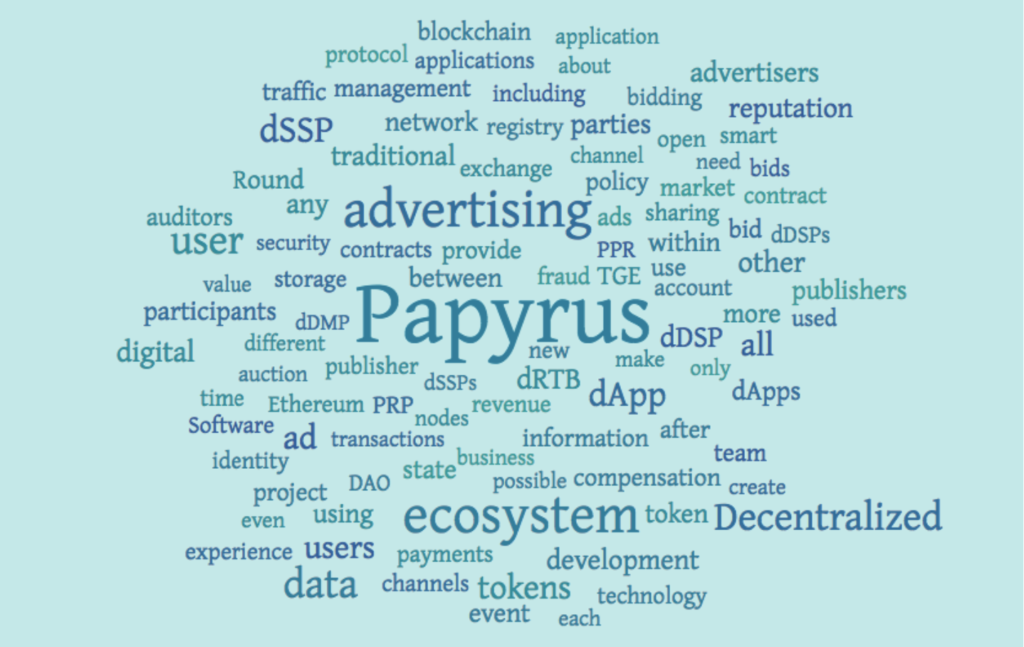Papyrus Global Ico Review
General
The URL of Papyrus instantly puts us in a serious, international mood: the .global domain is about 46 times less frequent in ICO projects than the already cheesy .io and an address with this extension costs $75 a year, which indicates that the founders have serious intentions. The name does not contain the typical elements “coin”, “block”, “crypto” or “chain”, for which the project gets an extra point. The site content has been translated into 8 major languages of the countries that have not yet banned ICOs – so far, everything looks like it’s straight from “Organising a Serious ICO for Dummies”. There’s really nothing to take fault with here: we have a team, advisers, a white paper in PDF format, a detailed bounty programme and a blog that is updated on average every day – the whole shebang. You get the impression that there’s an entire team of 100 people sitting in the Papyrus office (which, judging from the address on the website, is located in Singapore) dedicated to keeping the website shit-hot. To cut a long story short, Papyrus gets a solid 9 out of 10 in the Design category – 1 point had to be docked for the overly generic horizon image that has been used by many other ICOs, for example:

Detailed Analysis
Papyrus presents itself as a decentralised advertising ecosystem. The problem is as simple as can be and has been around since the times of Ancient Egypt: there is an eternal conflict between the users who have advertising shit onto their heads, the advertising agencies that want to make big bucks with their clients and at the same time shit more advertising onto users’ heads and the clients who think that shitty advertising will make users purchase their product.
The Papyrus plan is clear and straightforward: make adverts using blockchain, so that there’s no fraud and more people click on it. Oh yes, and we need the CTR of banners to be 30% again (as it was at the dawn of the interwebs) and advertising platforms to get 100% of the money from the client without any supercommission, other sophisticated nonsense or those silly modern operation schemes followed by advertising agencies around the globe that earn trillions of dollars for billions of people. Well fuck me.
Let me give you an example in order to draw an analogy. The company Food.io is a decentralised cryptoplatform for groceries. The gist of the project is that we want to change the game on the produce market. Why spend a fortune on petrol to go to the supermarket and support the big chains who charge an arm and a leg? Did you know that the price of your food includes the costs of renting the premises, logistics and the leaflets you get at the checkout? There is a solution – Food.io! Now, in case of hunger, you can go to the place where food grows yourself, pick it with your hands and eat it completely free of charge!!! If you’re not a vegetarian, you’ll have to run around a little bit and then tear your potential meal into pieces, but it doesn’t matter, because no one will find out about that: the system is decentralised and cryptoprotected against fraud! No more middlemen! Fuck the system.
For the idea, Papyrus gets 6 points out of 10. We docked 2 points for the fact that about 90% of other ICO projects also want to shake up the entire world and make it a better place in exactly the same way. Another 2 points have to be taken away for the video in which team members speak English. You’d think that with such a considerable budget they’d be able to afford a professional voiceover and record a version that would be more attractive to a potential cryptoinvestor.

Team
Here, everything is typical: 95% of the team members have Russian names. Although Papyrus itself is based in Singapore, the founders are all Russians – apparently, on one fine day the elite of the Singapore diaspora decided to get together and solve the international problem of advertising. Here’s a graph of detailed morphological analysis on the Papyrus project team conducted by the parser of our proprietary AI bot:
Names in the Team
- Sergei
- Aleksandr
- Nikolai
- Valery
- Others
Among the project advisors are high-profile names like Tim Brown, Marissa Kim, Stephen Peterson and Kylie Minogue. You might say, “Just a minute, Robert, why are they high-profile? The names Tim Brown and Marissa Kim don’t mean a fucking thing to me! And Kylie Minogue’s a bloody Australian singer!!!” and you’d be right. These names don’t mean anything to anyone and the Industry field on the LinkedIn profiles of all these people reads “I’ll work as an adviser to your ICO in exchange for tokens”.
The team seems to have been chosen randomly: the Facebooks and LinkedIns of most Papyrus staff still show their current, traditional places of work, where they are paid not in tokens, but in cold, hard cash. Maybe they just haven’t had time to update their profiles yet. Maybe they’re just too ashamed to do that.
We tried to get in touch with a few people from the Papyrus team to carry out standard verification procedures. Here’s a typical dialogue (all names have been changed beyond recognition):
David, reporter for the Cryptocurrency Times: Hello, Ivan! I have a question for you about fraud-prevention cryptotokens.
Ivan: What fucking token? Fuck off! It’s 3 a.m. here!!
Unfortunately, we forgot that in San Francisco we’re always one step ahead of the rest of the world and the height of our working day comes in the middle of the Singapore night. Nevertheless, we’ll be sure to contact all Papyrus employees tomorrow at lunch, Singapore time.
White Paper
A substantial 46-page PDF filled with important information. Here and there we can find lovely diagrams similar to the illustrations in IT textbooks: this is how the information goes from the server to the user and here the information is coming from the user to the server! There is also an action plan for the next three years:

Sorry, wrong picture.
The three-year plan actually looks like this:
- Release an alpha version that will solve 10% of the internet advertisement problem in one year (we start to rake in the cash)
- In two years, we release a beta version that will solve half of all problems (we get Saint Kitts and Nevis citizenship)
- In December 2019, we come out with a version that will solve absolutely all of everyone’s problems (we hope that Elon Musk won’t let us down and we’ll be able to fuck off to Mars by then)
By the way, instead of having to read 46 pages of white paper, we analysed the most common words in the text.
Indeed, there’s nothing new. Papyrus, advertisement, ecosystem, decentralised, DMP, RTB, DSP, tokens. I just saved you three hours.

Update on 24/10/2017
So, the Papyrus ICO is 12 days old now and what can we see? The advertising market reformers have crowdfunded about $400,000, which is 12 times less than the hard cap of $5 million that they so boldly set in their wet dreams of conquering the advertising market.
Taking into account the fact that an ICO raises 80% of its money in the first three days, Papyrus will end up with approximately $500,000, which — if you have a basic understanding of how the advertising market works, dear reader — should give you a clear picture of what is going on. The white paper states that 25% of the collected cryptocurrency will go towards “hiring teams of programmers to develop revolutionary algorithms and change the advertising market”. Let’s suppose that Papyrus hits the big time and gets a round $600K from its ICO. A quarter of this amount, i.e. $150K, is enough to hire one junior programmer in the US or three developers from the former USSR.
There can be only one conclusion: if you value your money (to be more precise, 18 bitcoins and 995 ethers), take it back immediately! However, the cunning founders of Papyrus didn’t bother setting a soft cap, so it won’t be easy to retrieve your hard-earned assets — all you’ll be able to do is sit back and watch as the exchange that the PRP token is launched on gradually reduces the font size in its mobile app so that the number of zeros after the decimal point fit onto the screen of your iPhone X.
We almost forgot about the most interesting thing – the Papyrus Telegram channels. I’m not sure that they are even worth talking about in light of the aforementioned sad events, but let’s try anyway. Papyrus has a couple of Telegram channels: one in English and one Russian.
The Russian channel is home to typical scenes that we see in EVERY SINGLE Russian Telegram channel for every single ICO. Crowds of semi-literate and very young people with a large social graph (demanding a bounty!) but no social life try to extract information from Papyrus employees on when they’ll get their tokens:
Linur pulatyev: –Do reports not have to be submitted for this bounty?
Artyom Pandursky: –Who’s taking part in the fb bounty?
Latish Latish: –Hello. How can i participate in the bounty? thank you
Dozens of messages about the same thing: why am I not part of the bounty? Where should I submit reports about the bounty? When will I be given tokens for the bounty?
A free piece of advice: if you’re planning an ICO, never make a Telegram channel for your Russian-speaking audience. If people want to shower you with their Bitcoins and Ethereum, they’ll find you out of the blue and ask all the important questions personally. Feigning activity in a Telegram chat of 100 people where the average age is 16 is pointless.
The English-language channel, however, is more lively: 800 people, some of whom have been confused into transferring money to Papyrus:

You can’t help but feel genuinely sorry for Paul and want to recommend that he keep his cryptocurrencies to himself. On the other hand, when we get around to organising our own ICO, we’ll send Paul a private message: he’s obviously a trusting guy and believes in all sorts of ridiculous miracles.
/rating_on.png)
/rating_half.png)
/rating_off.png)





